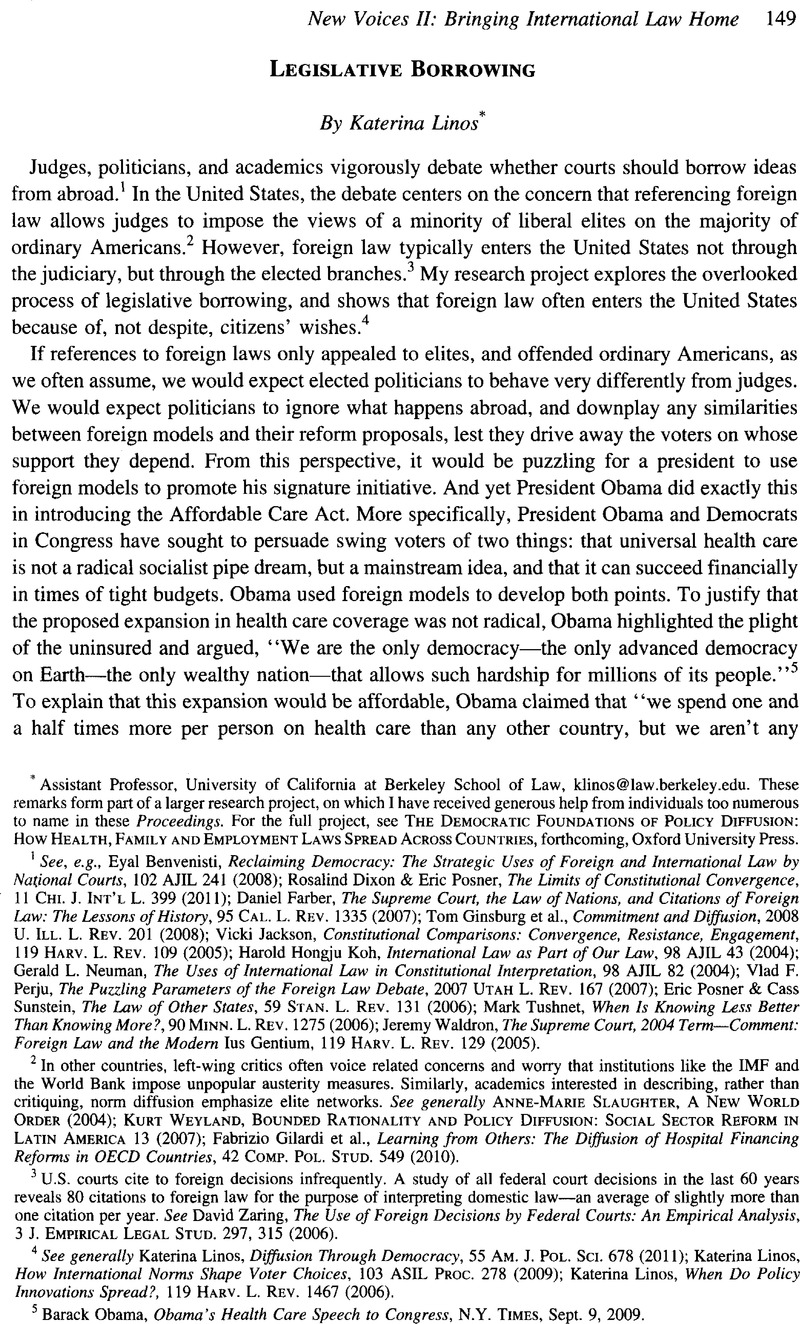No CrossRef data available.
Published online by Cambridge University Press: 28 February 2017

1 See, e.g., Benvenisti, Eyal, Reclaiming Democracy: The Strategic Uses of Foreign and International Law by National Courts, 102 AJIL 241 (2008)CrossRefGoogle Scholar; Dixon, Rosalind & Posner, Eric, The Limits of Constitutional Convergence, 11 Chi. J. Int’l L. 399 (2011)Google Scholar; Färber, Daniel, The Supreme Court, The Law of Nations, and Citations of Foreign Law: The Lessons of History, 95 Cal. L. Rev. 1335 (2007)Google Scholar; Ginsburg, Tom et al., Commitment and Diffusion, 2008 U. Ill. L. Rev. 201 (2008)Google Scholar; Jackson, Vicki, Constitutional Comparisons: Convergence, Resistance, Engagement, 119 Harv. L. Rev. 109 (2005)Google Scholar; Koh, Harold Hongju, International Law as Part of Our Law, 98 AJIL 43 (2004)CrossRefGoogle Scholar; Neuman, Gerald L., The Uses of International Law in Constitutional Interpretation, 98 AJIL 82 (2004)CrossRefGoogle Scholar; Perju, Vlad F., The Puzzling Parameters of the Foreign Law Debate, 2007 Utah L. Rev. 167 (2007)Google Scholar; Posner, Eric & Sunstein, Cass, The Law of Other States, 59 Stan. L. Rev. 131 (2006)Google Scholar; Tushnet, Mark, When it Knowing Less Better Than Knowing More?, 90 Minn. L. Rev. 1275 (2006)Google Scholar; Waldron, Jeremy, The Supreme Court, 2004 Term—Comment: Foreign Law and the Modern Ius Gentium, 119 Harv. L. Rev. 129 (2005)Google Scholar.
2 In other countries, left-wing critics often voice related concerns and worry that institutions like the IMF and the World Bank impose unpopular austerity measures. Similarly, academics interested in describing, rather than critiquing, norm diffusion emphasize elite networks. See generally Slaughter, Anne-Marie, A New World Order (2004)Google Scholar; Weyland, Kurt, Bounded Rationality and Policy Diffusion: Social Sector Reform in Latin America 13 (2007)Google Scholar; Gilardi, Fabrizio et al., Learning from Others: The Diffusion of Hospital Financing Reforms in OECD Countries, 42 Comp. Pol. Stud. 549 (2010)Google Scholar.
3 U.S. courts cite to foreign decisions infrequently. A study of all federal court decisions in the last 60 years reveals 80 citations to foreign law for the purpose of interpreting domestic law—an average of slightly more than one citation per year. See Zaring, David, The use of Foreign Decisions by Federal Courts: An Empirical Analysis, 3 J. Empirical Legal Stud. 297, 315 (2006)CrossRefGoogle Scholar.
4 See generally Linos, Katerina, Diffusion Through Democracy, 55 Am. J. Pol. Sci. 678 (2011)CrossRefGoogle Scholar; Linos, Katerina, How International Norms Shape Voter Choices, 103 ASIL Proc. 278 (2009)Google Scholar; Linos, Katerina, When do Policy Innovations Spread?, 119 Harv. L. Rev. 1467 (2006)Google Scholar.
5 Obama, Barack, Obama’s Health Care Speech to Congress, N.Y. Times, Sept. 9, 2009 Google Scholar.
6 Id.